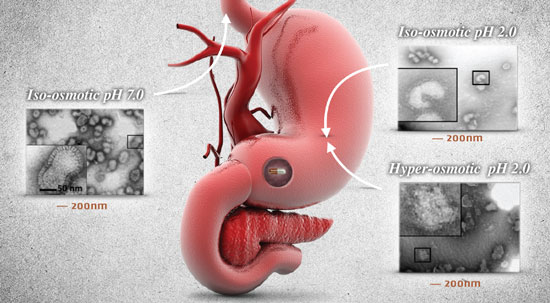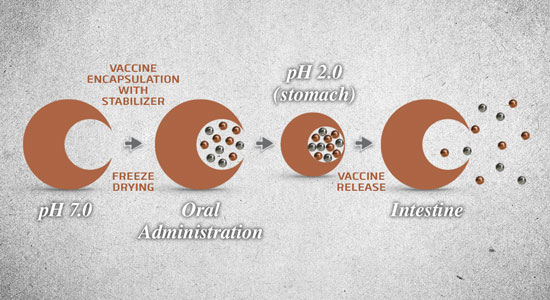| Posted: Mar 03, 2014 | |
Ingenuity the key to a promising new oral influenza vaccine |
|
| (Nanowerk Spotlight) More serious than the common cold, influenza viral infection has been responsible for major epidemics and pandemic respiratory disease in communities around the world. These epidemics come with substantial morbidity and mortality, accounting for 250,000 to 500,000 worldwide deaths each year[1] and are particularly dangerous for vulnerable and elderly populations with statistics showing that 90% of those who succumb to the severe illness are 65 years and older. The flu is also associated with high health care costs. In the U.S., more than $80 billion dollars[2] is spent annually as a result of influenza epidemics. | |
| Fortunately, vaccination has been proven to be an effective population health strategy to control the spread of disease and as a result, researchers continue to focus on refining conventional methods to reveal even better, more cost-effective and efficient vaccine delivery methods. | |
 |
|
| (click image to enlarge) | |
| Current immunization practices | |
| At present, intramuscular (IM), intradermal (ID) and intranasal (IN) administration are the three available routes for influenza vaccination. While injection-based transcutaneous methods are dominantly used, mucosal immunization has been gaining attention due to advantages including the ability to induce both mucosal and systemic immune responses as well as fewer health care resource requirements. The use of hypodermic needles in universal mass vaccination is inherently limiting due to vaccine administration requirements and safety concerns about bio-hazardous waste and needle reuse. Of different mucosal vaccination methods available, IN administration with the live attenuated influenza vaccine is presently certified for use in healthy persons aged 2–49 years in the US and 2–59 in Canada. Despite having better immune response advantage over IM method, inactivated IN vaccine formulation containing adjuvant was taken off the market due to safety concerns including a possible link to Bell’s palsy, a form of facial paralysis. | |
| Vaccination evolution | |
| In the last decade, researchers have been looking at alternative vaccine delivery methods and formulations. Oral vaccines hold great promise for people in developing countries as well as for pandemic influenza preparation. This delivery mechanism is cost-effective, eliminates bio-hazardous waste, saves on vaccine production, transportation and storage costs (cold chain management) and the drug itself does not need to be administered by highly trained health personnel. | |
| However, despite the clear advantages and considerable efforts that have been devoted to develop oral influenza vaccines, there is still no commercially available oral influenza vaccine on the market. This is mainly due to the instability of antigens in the stomach and concerns about reduced drug efficacy. In fact, earlier studies in vivo animal have consistently demonstrated that orally administered influenza vaccine does not produce satisfactory levels of immunogenicity as compared to other routes of administration, mainly due to the destabilization of oral vaccines in the stomach. As such, the vaccine must contain a larger quantity of antigens to induce a similar level of protective immunogenicity, meaning the perceived economic benefits attributed to inactivated oral influenza vaccine are then compromised. | |
 |
|
| (click image to enlarge) | |
| Novel discoveries at Ingenuity Lab | |
| Nanotechnology researchers at Ingenuity Lab in Edmonton, Alberta, Canada are actively seeking to make vaccine history. They are developing an innovative vaccine formulation and delivery method for oral influenza immunization that will greatly impact the health and wellbeing of populations around the world. | |
| The team has successfully overcome conventional oral influenza vaccine barriers with their mechanistic understanding of the effects of the physicochemical gastric environment on vaccine stability. This feat was accomplished using a nanotechnology-based vaccine characterization technique to observe time-dependent morphological change of the vaccine under various gastric environments. | |
| Ingenuity researchers recently published their findings in PLOS ONE (“A mechanistic study on the destabilization of whole inactivated influenza virus vaccine in gastric environment”). In this work, which was supported by the Bill & Melinda Gates Foundation, scientists found that the presence of hyper-osmotic stress in acidic medium had a significant destabilizing effect on the stability of the whole inactivated virus (WIV) vaccine; a marked destabilization of influenza vaccine was observed at higher hyper-osmotic stress than 0.3 osmolarity at pH 2.0 and 37 °C. | |
| They also noted that low pH-induced denaturation of antigenic proteins and particle aggregation play a critical role in the initial rapid vaccine activity loss, and irreversible membrane deformation of vaccine particles’ wall causes additional activity decrease during further incubation under hyper-osmotic conditions. As predicted in the report, a maximum level of stability can be maintained at both hypo- and iso-osmotic gastric conditions, but hyper-osmotic conditions result in a minimum level of vaccine activity. As such, the Ingenuity Lab study suggests that in order to maintain a high level of vaccine efficacy, it is critical to administer future oral influenza vaccines on an empty stomach and/or to develop a vaccine formulation that can protect WIV vaccines against hyper-osmotic pressure as well as low pH in the gastric environment. | |
| While Ingenuity’s leading-edge research will underpin the development of optimal vaccine formulations for maintaining a high level of vaccine activity in a gastric environment, the ultimate goal at the province’s first nanotechnology accelerator lab is to develop a new oral vaccine delivery system using pH sensitive micro-particles that have been engineered to actively protect oral influenza vaccine in the acidic gastric environment. | |
| The combination of an optimally designed vaccine formulation and pH-sensing micro-particles will mean increased vaccine efficacy, a dose-sparing effect and cost reduction. This nanotechnology discovery also opens the door to a myriad of new vaccine possibilities, breaking down traditional immunization barriers in developing nations and beyond. Thanks to ingenuity, the vaccinations of the future will be more efficient, safer and much more accessible to those who need them most. Novel oral vaccines will truly be a revolutionary health breakthrough for populations around the globe. | |
| References | |
| [1] Reference: Fauci, A.S. (2006) Emerging and re-emerging infectious disease: Influenza as a prototype of the host-pathogen balancing act. Cell 124: 665-670 | |
| [2] Ref: Molinari, N. A. M., Ortega-Sanchez, I. R., Messonnier, M. L., Thompson, W. W., Wortley, P. M., Weintraub, E., & Bridges, C. B. (2007). The annual impact of seasonal influenza in the US: measuring disease burden and costs. Vaccine, 25(27), 5086-5096. | |
|
Source: Ingenuity Lab
|
|
|
Become a Spotlight guest author! Join our large and growing group of guest contributors. Have you just published a scientific paper or have other exciting developments to share with the nanotechnology community? Here is how to publish on nanowerk.com. |
|
